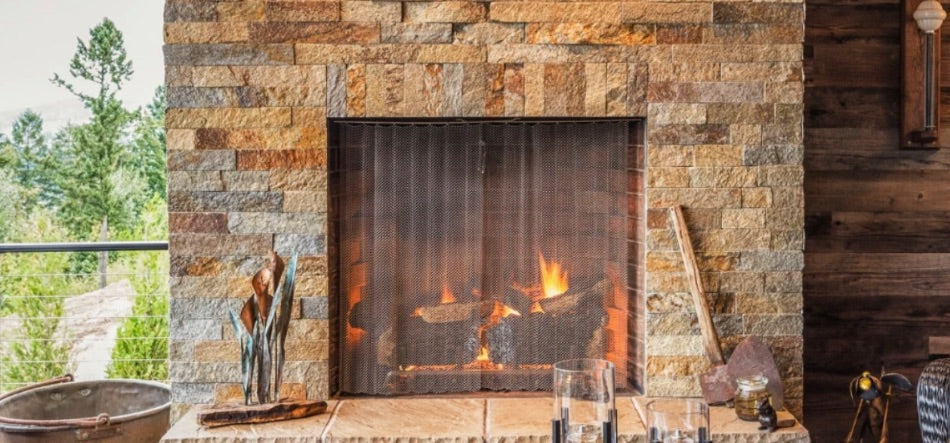
How To Close Off A Fireplace

If you have an old masonry fireplace in your home, you can save yourself a ton of money on your heating bills by blocking them off.
You can decide whether you want to block your fireplace off temporarily - if you plan on using it again in the future, or permanently.
There are several different methods in which you can block off your fireplace which we’re going to address in this article.
Temporarily Sealing a Masonry Fireplace
Depending on your handiness level, there are two ways in which you can block your fireplace: By purchasing a seal to fit your needs, or by making your own seal.
Purchasing a Fireplace Sealer
There are three different types of masonry fireplace sealers you can buy online through Amazon.
Option 1: Chimney Balloon
A chimney balloon is an inflatable, balloon-like seal. When installing a chimney balloon, it should be placed either just above the damper, or at the bottom of the smoke shelf.
Chimney balloons are available in hundreds of different sizes, so you should be able to fit one to fit your own.
It’s also worth noting that chimney balloons are also referred to as chimney pillows, fireplace pillows, flue blocker, fireplace blocker, fireplace plug and draft stopper.
Option 2: Rectangular Chimney Pillow
Another effective way to stop a fireplace draft is to use a large Fireplace Plug, which are also referred to as chimney pillows. These are placed up against the damper and have an adjustable height pole to keep the pillow tight.
These will fit most masonry fireplaces, and are fairly easy to uninstall. All you have to do is deflate the pillow and remove it the next time you want to use the fireplace.
As well as reducing draftiness, chimney pillows are effective for reducing outside noise from coming into your chimney and reducing any debris that might fall down your chimney.
Option 3: Decorative Cover For Your Fireplace Opening
If your fireplace has a metal screen, you can buy a cover which will attach to the metal screen using magnets. These fabric covers are often fire-resistant and are very easy to install and uninstall.
Making Your Own Temporary Seal
If your DIY skills are up to par, you can easily make your own fireplace seal.
Firstly, look up into your fireplace opening and look at the shape of the opening just below the damper as this is where you want to install the seal.
Measure from each side of the opening just below the damper seal. Trace a pattern on cardboard using the measurements.
Then, cut the pattern and check if it fits, making adjustments where necessary and use this as a template.
There are two ways in which you can create a seal.
Firstly, you can use an insulating foam board seal. Use your cardboard template to cut the foam board.
Once done, press the foamboard seal into place just under the damper. To keep the foam board in place, use steel insulation springs.
The second option is to use insulating foam and plywood. Once again, you’re going to need your cardboard template to cut out a piece of plywood.
Next use a foam pipe insulation around the edges of the plywood, and insert the board just below the damper. The pipe insulation should press against the brick to create an air-tight seal.
Permanently Sealing Off Your Fireplace

You then want to use caulk (joint sealer) or weatherstrip to seal it off and keep it in place.
If you want more effective or longer lasting results, it’s going to take a lot more effort.
Step 1
Call in professional fireplace cleaners to clean your chimney and fireplace thoroughly. Any debris must be cleared.
Step 2
Towards the top of the chimney pipe, there will be a chase cap which is where the smoke escapes. Next to it you will find a roof-like structure that prevents any rainwater from entering the chiney.
This roof-like structure needs to be removed along with the pipe connected to it. Take a scrap piece of metal and seal the new opening.
If needed, you can add additional barriers to make the chimney soundproof. Then the damper needs to be closed.
Step 3
Measure the fireplace opening so you can purchase the right amount of bricks to seal. It’s also important to purchase a few air bricks, which will allow air to flow through.
Once purchased, make a row of bricks about twelve inches from the existing opening, making sure you place the air bricks in the middle of the row. Once the bricks are laid, let them set.
Step 4
The next step is to apply a skim coat of concrete, but make sure you leave the air bricks open. Once the concrete starts to dry, create some scratches on its surface using a nail. This will allow for the plaster to stick to the bricks properly.
Step 5
Once the concrete is dry, prepare some plaster and start applying it to the surface of the brick using a light coat - do not forget to leave the air bricks exposed. Continue the process until the whole surface is covered (minus the air bricks).
Step 6
Once the plaster is dry, install an ornamental grill to conceal the air brick. You can buy these online or at hardware stores, and they can either be glued on, or nailed in place.
Step 7
If you want, you can now cover the fireplace using drywall. First, clean down the surface and the ground around it.
Use furring strips to attach the drywall, making sure you mud and tape the seams. Finally, you can paint the drywall to match the color scheme of your room.
And there you have it, several different ways to temporarily and permanently close off your fireplace.

